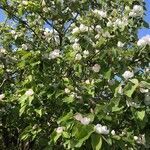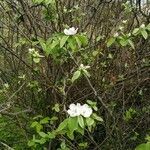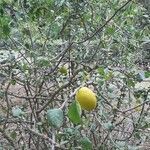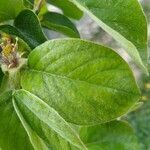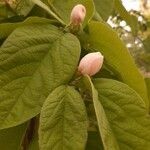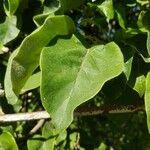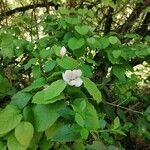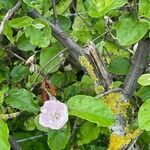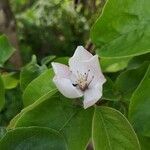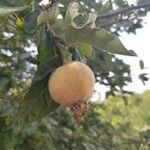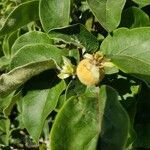Large shrub or small tree up to 5-(8) m high and several m diam. when mature; trunk short or 0 and plants sometimes forming small suckering thickets; upper branches often arching; stems dark brownish red and felted when young. Petiole (4)-6-14 mm long; blade ovate to broad-elliptic, oblong or suborbicular, 30-80 × 25-50 mm, rounded to subacute at apex, obtuse at base, white-tomentose at first on upper surface, becoming glabrate and dull, white-to grey-tomentose below; margin entire; stipules lanceolate. Fls 30-50 mm diam. Sepals densely tomentose, persistent; lobes oblong, acute, glandular, sharply reflexed. Petals oblong, 12-25 mm long, rounded or slightly emarginate. Fr. pyriform or subglobose, usually 80-150 mm long, yellow, ± finely tomentose, fragrant, with apical cavity.
A spreading bushy tree. It grows up to 5-8 m high and spreads 3-6 m wide. It forks low down on the trunk into crooked limbs. The leaves are large, and deep green above and downy underneath. They occur on young twigs. It loses its leaves. The flowers can be 5 cm across and mostly pale pink. The fruit are pear shaped and 15 cm long with hard flesh. The fruit can be 1 kg in size. They are yellow when ripe. They are edible when cooked.
Shrub or small tree, up to 6 m high; deciduous. Leaves alternate, simple with blade ovate to elliptic, ± 100 x 50 mm, margins entire. Flowers: solitary; sepals 5, hairy on outer side; corolla ± 50 mm in diameter, petals 5, white to pink; Sep.-Nov. Fruit a pome, ± pear-shaped, 70-120 x 60-90 mm, with persistent sepals at top, densely appressed hairy, golden-yellow when ripe.
Branches purplish red, densely tomentose young, purplish brown, glabrous with age. Leaves: petiole 3–10 mm, tomentose young; blade 5–10 × 3–5 cm, base rounded or subcordate, apex acute or emarginate, lustrous or semilustrous. Pedicels 0–5 mm. Flowers: sepals 5–6 mm, apex acute; petals 15–20 mm. 2n = 34.
